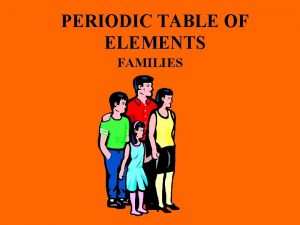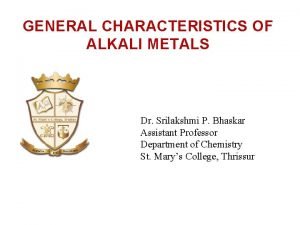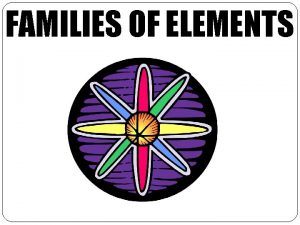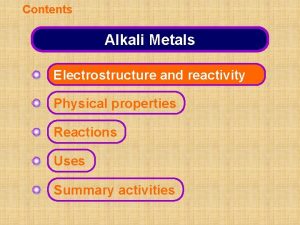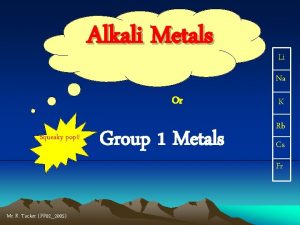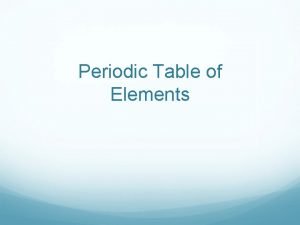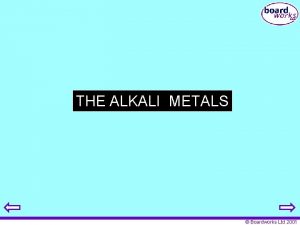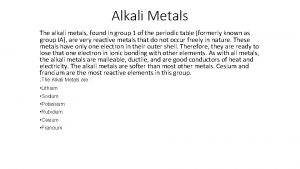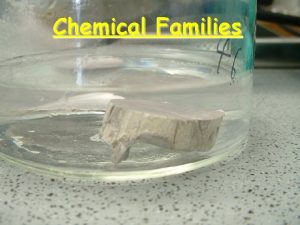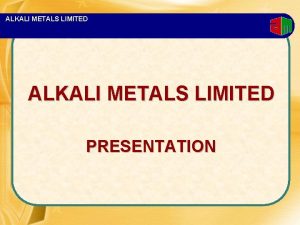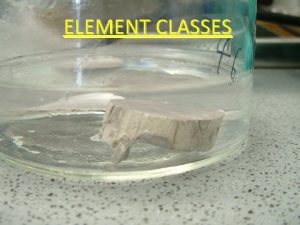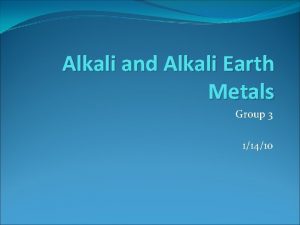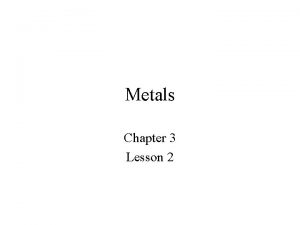THE ALKALI METALS Canvas lesson 04 The Alkali














- Slides: 14

THE ALKALI METALS Canvas lesson: “ 04 – The Alkali Metals”

Learning Goals 1. Identify the location of the alkali metals on the Periodic Table 2. List of the properties of the alkali metals 3. Explain why Group 1 metals increase in reactivity going down the group.

Group 1 – The Alkali Metals The elements in group 1, on the left of the periodic table, are called the alkali metals. lithium Li sodium Na potassium K rubidium Rb caesium Cs francium Fr These metals are all very reactive and are rarely found in nature in their elemental form. Identify the location of the alkali metals on the Periodic Table

Why are they called, ”Alkali Metals? ? The alkali metals are so reactive that, as elements, they have to be stored in oil. This stops them reacting with oxygen in the air. Alkali metals are soft enough to be cut with a knife, and the most common alkali metals, lithium, sodium and potassium, all float on water. The elements in group 1 also react with water and form alkaline compounds. This is why they are called alkali metals. List of the properties of the alkali metals

Why are they called, ”Alkali Metals? ? The characteristic properties of the alkali metals are: l They are soft and can be cut by a knife. Softness increases going down the group. l They have a low density. Lithium, sodium and potassium float on water. l They have low melting and boiling points. These properties mean that the alkali metals are different to typical metals. However, alkali metals do also share some properties with typical metals: l They are good conductors of heat and electricity. l They are shiny. This is only seen when alkali metals are freshly cut. List of the properties of the alkali metals

What are the trends in density?

What is the trend in density? The alkali metals generally become more dense going down the group, but the trend is not perfect because potassium is less dense than sodium. Element Density (g/dm 3) lithium 0. 53 sodium 0. 97 potassium 0. 86 rubidium 1. 53 caesium 1. 87 Water has a density of 1 g/dm 3. Which elements in group 1 will float on water?

What are the trends in melting point?

What are the trends in boiling point?

What is the trend in melting and boiling points? The melting points and boiling points of alkali metals decrease going down the group. Element Melting point (°C) Boiling point (°C) lithium 181 1342 sodium 98 883 potassium 64 760 rubidium caesium 39 28 686 671 The melting and boiling points decrease going down group 1 because the atoms get larger. Melting points are lower than for typical, transition, metals, because alkali metals only have 1 electron in their outer shell. Not much heat energy is needed for this electron to be lost.

Electron structure All alkali metals have 1 electron in their outer shell. This means that: lithium 2, 1 l They can easily obtain a full outer shell by losing 1 electron. sodium 2, 8, 1 l They all lose their outer shell electron in reactions to form positive ions with a +1 charge. l They have similar physical and potassium chemical properties. 2, 8, 8, 1

Electron structure and reactivity increase in reactivity The reactivity of alkali metals increases down the group. What is the reason for this? Li Na K Rb Cs l The size of the element’s atoms, and the number of full electron shells, increases down the group. l This means that, down the group, the electron in the outer shell gets further away from the nucleus and is shielded by more electron shells. l The further away an electron is from the positive attraction of the nucleus, the easier it can be lost in reactions. l This means that reactivity increases with the size of the atom.

How do the alkali metals react with oxygen? All alkali metals react with oxygen in the air to form metal oxides. This produces a layer of dull oxide on the surface of the metal, called tarnish. The speed with which alkali metals react with oxygen in the air increases going down the group: l lithium – tarnishes slowly l sodium – tarnishes quickly l potassium – tarnishes very quickly. Why are alkali metals stored in oil? The oil prevents them from reacting with oxygen and tarnishing.

HOMEWORK: DUE: Monday (15. 02. 16) TASKS: 1. Complete any work not finished today. 2. Complete worksheet, “Isotopes. ” HOMEWORK
 Metals metalloids and nonmetals periodic table
Metals metalloids and nonmetals periodic table Ferrous metals vs non ferrous metals
Ferrous metals vs non ferrous metals Characteristics of metals
Characteristics of metals Matter and materials grade 6
Matter and materials grade 6 Grade 7 term 2 natural science
Grade 7 term 2 natural science Example of metal
Example of metal Reactive alkali metals
Reactive alkali metals Periodic table element families
Periodic table element families Which is more reactive alkali metals or halogens
Which is more reactive alkali metals or halogens General characteristics of alkali metals
General characteristics of alkali metals Common properties of alkali metals
Common properties of alkali metals General characteristics of alkali metals
General characteristics of alkali metals Periodic table color coded
Periodic table color coded Where is the most reactive elements on the periodic table
Where is the most reactive elements on the periodic table Fun facts about alkali metals
Fun facts about alkali metals







